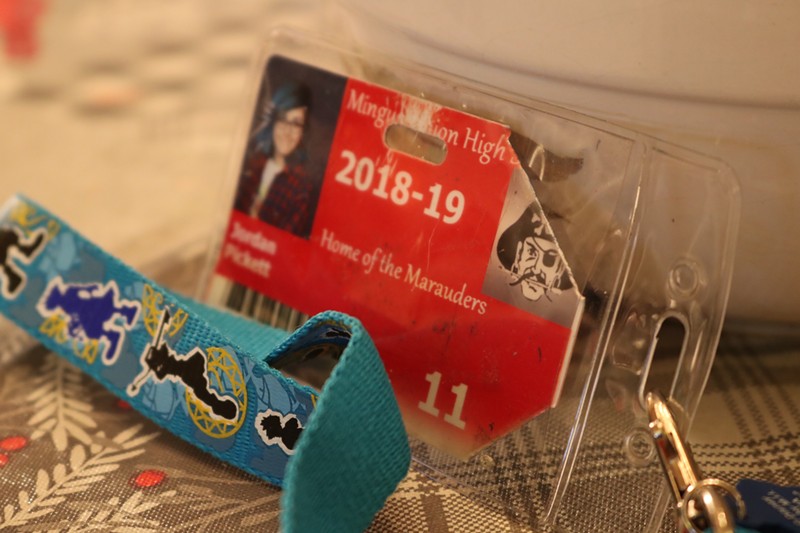Jordan Pickett began her junior year at Mingus Union High School in Cottonwood behind on academic credits. Because she suffers from severe anemia, Pickett often had to travel to Phoenix to receive medical attention, causing her to miss classes.
A combination of absences and not passing her classes meant that last fall, instead of the gray student identification card worn by her fellow juniors, the 17-year-old was assigned a bright-red badge. The I.D. card, visible at all times, signaled to her teachers and classmates that Pickett was in trouble academically.
But the school's use of these badges as a kind of public-shaming technique caught the attention of the Arizona chapter of the ACLU after Pickett's family contacted the organization.
On December 28, the legal director for the ACLU of Arizona, Kathleen Brody, sent a letter to the Mingus Union High School District superintendent demanding that the district end a policy that "publicly identifies and shames underperforming students."
At the beginning of this school year, MUHSD implemented the red-versus-gray badge policy, the ACLU says. In theory, the badge system is supposed to distinguish upperclassmen, who have open-campus privileges, from underclassmen. (The official Mingus school colors are red and gray.)
A junior like Pickett forced to wear a red badge means that the student's open-campus privileges, such as the ability to leave school grounds during the lunch hour, have been revoked.
In her letter, Brody argued that the so-called scarlet badge policy violates several federal laws, including the Family Educational Rights and Privacy Act, commonly known as FERPA, and the Americans With Disabilities Act. Under FERPA, which requires schools to maintain the privacy of students' educational records, Brody said that a badge policy that publicly identifies underperforming students is illegal.
"The public display of student education records through the creation of 'scarlet badges' exemplifies the type of student privacy violation that spurred the passage of FERPA and must immediately cease," Brody wrote.
Additionally, laws like the ADA, which protect students with disabilities, prohibit a policy that discriminates against students by forcing them to wear a scarlet badge, Brody wrote. The policy also violates the Equal Protection Clause of the 14th Amendment, she said, because the practice serves no legitimate interest.
"Forcing low-performing students to publicly display their academic information serves no legitimate educational interest nor is it rationally related to an important educational goal," Brody wrote.
Pickett's mother, Jennifer Lansman, said that when Mingus students see the badges, they make snide comments about classmates who are forced to wear them, saying they "must be stupid, or they're failures." Students often try to hide the badges or cover them up by putting stickers on it, she said.
"They get told by faculty or staff, you can't do that," Lansman said. "And to me, you do that because you're ashamed of something that you have on you."
Lansman contacted the Arizona chapter of the ACLU in August to alert the organization to the issue. At a September 13 meeting of the MUHSD governing board, Pickett and two other students raised the badge issue during the public comment session, Lansman said, but the board couldn't respond to their concerns.
Previously, students had to wear badges, Lansman said, but they were not color-coded to identify students falling behind academically. Pickett's badge features the number 11, which shows her class status as a junior, but unlike her junior-year classmates, the badge is the red color worn by freshman and sophomores.
Marcela Taracena, a communications coordinator for the ACLU, said that the school district is aware that the policy is damaging because students raised the practice at the September board meeting. The ACLU is simply asking the school district to get rid of the scarlet badge policy, she said.
"There’s no need for juniors and seniors to wear a badge that basically says they’re failing," Taracena said.
Mingus Union High School's student population is approximately 1,200, and the district, which operates only the high school and an online academy, serves students from Cottonwood and the Verde Valley.
An attorney representing the school district declined to comment on the specifics of the challenge from the ACLU. Susan Segal, who works for the firm Gust Rosenfeld, said that she could provide more details later. “Mingus Union High School District is looking into the legal issues,” Segal said.
Pickett, meanwhile, is currently in two credit-recovery classes to to make up her missing credits, Lansman said. And while her daughter is more focused on graduating on time than regaining a symbolic gray badge, Lansman hopes the district ends the policy.
"I think demoralizing students because they didn’t get the grades they needed shouldn’t be okay," she said.
Update, January 2, 5:36 p.m. Susan Segal, the attorney for the school district, responded to the ACLU on Wednesday with a letter characterizing the badges as a form of directory information that is acceptable to disclose under FERPA.
"Jordan has a red identity badge because she does not have enough credits to be a junior," Segal wrote. The number 11 will be taken off her badge, according to Segal's letter.
Pickett's mother, Segal wrote, has not opted out from the disclosure of grade level as a form of publicly available information under FERPA. "She is free to do so at any time," Segal wrote. "In that instance, the District will issue her daughter a student ID without a grade level designation, either in color or number."
The red badges simply function as one of the school's official colors of red and gray, the attorney argued. "Thus, any characterization of the badges as a 'scarlet' letter that implies the use of the color is punitive is misleading," Segal wrote. "Had the school colors been green and gold, the badges would have those colors."
Going forward, the school district may remind parents in a letter that they can opt out, or use sign-out sheets for students whose badges do not show their grade level, Segal said.
Correction: A previous version of this article misstated the first name of the legal director for the ACLU of Arizona. She is Kathleen Brody, not Kathryn.
[
{
"name": "Air - MediumRectangle - Inline Content - Mobile Display Size",
"component": "18478561",
"insertPoint": "2",
"requiredCountToDisplay": "2",
"watchElement": ".fdn-content-body",
"astAdList": [
{
"adType": "rectangle",
"displayTargets": "mobile"
}
]
},{
"name": "Editor Picks",
"component": "16759093",
"insertPoint": "4",
"requiredCountToDisplay": "1",
"watchElement": ".fdn-content-body",
"astAdList": [
{
"adType": "rectangle",
"displayTargets": "desktop|tablet"
},{
"adType": "rectangle",
"displayTargets": "desktop|tablet|mobile"
}
]
},{
"name": "Inline Links",
"component": "17980324",
"insertPoint": "8th",
"startingPoint": 8,
"requiredCountToDisplay": "7",
"maxInsertions": 25
},{
"name": "Air - MediumRectangle - Combo - Inline Content",
"component": "16759092",
"insertPoint": "8th",
"startingPoint": 8,
"requiredCountToDisplay": "7",
"maxInsertions": 25,
"watchElement": ".fdn-content-body",
"astAdList": [
{
"adType": "rectangle",
"displayTargets": "desktop|tablet"
},{
"adType": "rectangle",
"displayTargets": "desktop|tablet|mobile"
}
]
},{
"name": "Inline Links",
"component": "17980324",
"insertPoint": "8th",
"startingPoint": 12,
"requiredCountToDisplay": "11",
"maxInsertions": 24
},{
"name": "Air - Leaderboard Tower - Combo - Inline Content",
"component": "16759094",
"insertPoint": "8th",
"startingPoint": 12,
"requiredCountToDisplay": "11",
"maxInsertions": 24,
"watchElement": ".fdn-content-body",
"astAdList": [
{
"adType": "leaderboardInlineContent",
"displayTargets": "desktop|tablet"
},{
"adType": "tower",
"displayTargets": "mobile"
}
]
}
]











